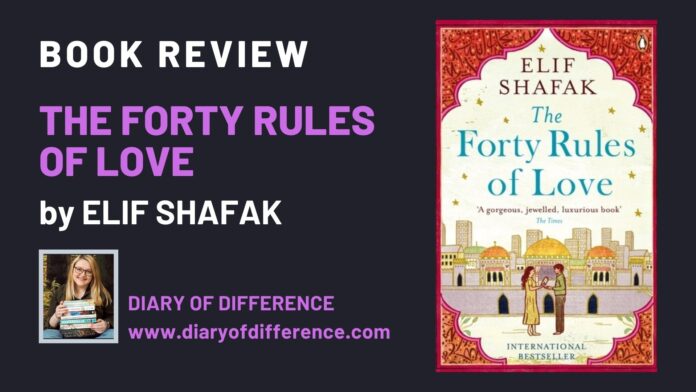In a world where stories of love often swirl around fleeting romance or grand gestures, The forty Rules of Love offers a distinctive voyage into the deeper, transformative dimensions of affection and spirituality. This novel, weaving together past and present, mysticism and reality, invites readers to contemplate not just the nature of love, but the profound journey of self-revelation that it can inspire. in this reflective review, we delve into the layers of Elif Shafak’s work, exploring how the intertwining narratives and poetic wisdom challenge conventional understandings and open pathways to inner awakening. Here begins an unveiling of the spiritual journeys encapsulated within the pages of this thought-provoking tale.
Exploring the Intertwined Narratives of Love and Mysticism That Shape the Forty Rules of love’s unique Storytelling Experience
The narrative brilliance of the Forty Rules of Love lies in its seamless weaving of love’s earthly experiences with the ethereal essence of mysticism, creating a tapestry that invites readers to journey beyond conventional storytelling. Through alternating timelines-the contemporary life of Ella and the 13th-century world of Rumi and Shams-the novel reveals how spiritual awakening and romantic love are not opposing forces but reflections of the same worldwide pursuit. This dual structure illuminates the transformative power of love, suggesting it as a gateway to deeper self-awareness and divine connection. In doing so, the story challenges us to reconsider our own relationships, urging a surrender to vulnerability, faith, and the unknown.
Several key elements contribute to this unique storytelling experience, each fostering a profound dialog between love and spirituality:
- Interwoven narratives: The past and present converse, mirroring themes of longing and enlightenment that transcend time.
- Philosophical reflections: Embedded within poetic prose, these reflections challenge rigid perceptions of love, urging openness.
- Character transformation: Personal growth acts as a spiritual metaphor, illustrating the internal journey catalyzed by love.
| Aspect | Love | Mysticism |
|---|---|---|
| Nature | Emotional, relational | Transcendent, contemplative |
| Purpose | Connection, intimacy | Unity, enlightenment |
| Experience | Heartfelt, personal | Universal, spiritual |
A Deep Dive Into the themes of Spiritual Growth and Inner transformation Woven Throughout the Novel’s Dual Timelines

The novel expertly intertwines two timelines, each serving as a mirror reflecting the profound journey of spiritual awakening and personal transformation. In the 13th-century story of Rumi and Shams, readers witness a mystical exploration of love, surrender, and the dismantling of ego, which acts as a timeless beacon for the modern-day narrative.This layered storytelling technique illuminates how spiritual growth transcends centuries, inviting readers to engage with the idea that inner change is both an intimate personal voyage and a universal quest. The parallel narratives emphasize that true transformation often comes not from external events but from an evolving internal consciousness-one that embraces vulnerability, empathy, and a deeper connection to the divine.
Throughout the novel, key themes are revisited with subtle variations, revealing the cyclical nature of spiritual evolution. Consider the following elements that recur in both timelines, weaving a complex tapestry of inner growth:
- Love as a Catalyst: Both narratives demonstrate how love acts as a transformative force, shattering old beliefs and opening the heart to compassion.
- Breaking Conventional Boundaries: The characters challenge societal norms and personal limitations, modeling courage in pursuit of spiritual truth.
- The Quest for Meaning: introspection and questioning highlight the importance of seeking purpose beyond material existence.
- Embracing Mystery: Acceptance of uncertainty and the unknown becomes a path toward enlightenment.
| Theme | 13th-century Timeline | Contemporary Timeline |
|---|---|---|
| Love | Rumi’s spiritual awakening through Shams’ friendship | Ella’s transformation via correspondence and self-discovery |
| Ego | Shams challenges Rumi’s ego to break spiritual barriers | Ella confronts her own fears and doubts |
| Freedom | Breaking social conventions for divine connection | Choosing emotional liberation over societal expectations |
The Role of Rumi and Shams of Tabriz as Catalysts for Change in the Characters’ Emotional and spiritual Evolution

The influence of Rumi and Shams can be seen in how characters evolve across several dimensions:
- Emotional Depth – cultivating vulnerability and embracing the fullness of human experience;
- Spiritual Insight – challenging orthodox beliefs and fostering a more intimate,personal connection with the divine;
- Transformative Dialogue – engaging in conversations that dismantle ego-driven mindsets and open pathways to empathy and unity.
| Character | Before Encounter | After Encounter |
|---|---|---|
| Ella | Emotionally guarded, skeptical of love | Open-hearted, embraces vulnerability |
| Rumi | poetic yet conventional | Radically free, spiritual revolutionary |
| Shams | Mysterious wanderer | Spiritual catalyst, transformative presence |
How the Author Bridges Contemporary Life with Sufi Philosophy to Create a Timeless Reflection on Human Connection

In a masterful intertwining of eras, the author transcends temporal boundaries by weaving the sacred mysticism of Rumi’s 13th-century world with the chaotic pulse of modern life. This narrative dance grants readers an intimate passport into the realm of Sufi philosophy, where love is not merely an emotion but a transformative force. The contemporary storyline, centered on Ella’s quest for meaning, acts as a mirror to the ancient wisdom imparted through Shams’ teachings, revealing that the quest for connection and self-discovery remains a universal human experience. Through this dual timeline,the book breathes life into age-old concepts-such as surrender,unity,and divine love-making them accessible and resonant for a generation marked by digital distractions and fleeting interactions.
Key elements that enrich this bridge include:
- Parallel narratives that contrast yet complement each other’s emotional landscapes.
- Proverbs and aphorisms from Sufi tradition, delicately embedded within modern dialogues.
- Characters that embody Sufi archetypes, reimagined with contemporary sensibilities.
| Aspect | Contemporary Life | Sufi Philosophy |
|---|---|---|
| View on Love | Romantic and personal fulfillment | Divine, unconditional, transformative |
| Search for Meaning | External validation & career success | Inner peace & spiritual awakening |
| Human Connection | Physical & social networks | Soulful union beyond material existence |
Ultimately, this fusion crafts a timeless reflection on human connectivity, highlighting that underneath the noise of modernity lies a shared yearning for profound spiritual intimacy. The author does not impose Sufi philosophy as dogma but rather gently invites readers into a contemplative space where ancient wisdom quietly dialogues with present realities.By doing so, the novel becomes more than just a story; it evolves into a living tapestry where the threads of past and present interlace, encouraging a deeper awareness of how love bridges all divides-temporal, cultural, and personal alike.
An Analysis of the forty Rules as Guiding Principles for Compassion, Forgiveness, and Unconditional Love in Daily Life
The Forty Rules offer more than mere guidelines; they serve as transformative beacons fostering deeper compassion, genuine forgiveness, and the embrace of unconditional love in everyday interactions. These principles encourage a conscious shift from judgment to empathy, urging us to perceive others’ pain and joy as reflections of our own. Emphasizing surrender and openness,they dissolve barriers of ego and resentment,paving the way for healing connections that transcend superficial divisions. In living these rules, daily conflicts become opportunities for understanding rather than confrontation, making every encounter a dance of spiritual growth and mutual respect.
At the heart of these guidelines is a simple yet profound truth: love is limitless and often disguised through struggle and imperfection. Applying these rules can reshape our approach to life through key themes:
- Radical Acceptance: Embracing all facets of human experience without resistance.
- Active Compassion: seeing the divine within each being and acting with kindness accordingly.
- Forgiveness Beyond Forgetting: releasing bitterness to free the soul, while honoring lessons learned.
- Living Unconditionally: Offering love without prerequisites, expecting nothing in return.
The Narrative Technique of parallel Storytelling and Its Impact on Reader Engagement and Emotional resonance
The novel expertly intertwines two distinct narratives-one set in 13th-century Konya and the other in 21st-century Istanbul-creating a vivid tapestry that challenges readers to consider the timeless nature of love, spirituality, and transformation. This duality invites an immersive reading experience as each storyline mirrors and contrasts the other, enriching the overall thematic depth. By alternating perspectives, the author invites readers to actively piece together connections, fostering heightened engagement as they anticipate how the past and present inform each other.
Such a storytelling technique also amplifies the emotional resonance of the novel, as the parallels between the characters’ journeys evoke empathy and introspection. The simultaneous unfolding of love stories across different eras encourages readers to explore universal truths through a fresh lens. Below is a fast comparison of how key elements in each narrative complement one another, enhancing the reader’s emotional journey:
| Element | 13th-Century Storyline | 21st-Century Storyline |
|---|---|---|
| Spiritual Quest | Rumi’s search for divine love | Ella’s journey toward personal awakening |
| Romantic Love | Rumi & Shams’ transformative bond | ella & Aziz’s evolving relationship |
| Audience connection | historical mysticism and poetry | Modern-day struggles and self-discovery |
Detailed Insights Into the Symbolism and Metaphors That Enrich the Text’s Spiritual and Philosophical Dimensions
Elif Shafak’s narrative masterfully interweaves intricate symbolism that breathes depth into the spiritual journey of love and self-discovery.The recurring motif of the “forty rules” operates not merely as a thematic structure but as a metaphorical compass guiding readers through the labyrinth of human connection and divine union. Each rule reflects a profound spiritual truth, inviting introspection on the paradoxes of existence-how love transcends reason, how pain births wisdom, and how surrender leads to ultimate freedom. The characters’ intertwined paths between the 13th-century mystic Rumi and the contemporary Ella serve as living allegories of the timeless dance between soul and ego, a metaphor encapsulated in the cyclical storytelling that mirrors the eternal quest for meaning.
Embedded within the prose are vivid symbols like the whirling dervish, whose spinning is more than ritualistic movement-it epitomizes the soul’s journey towards divine ecstasy and balanced detachment. Nature imagery, including roses and moonlight, act as metaphors for beauty’s transient nature and the illumination of hidden truths. The novel also cleverly employs the concept of duality-life and death,joy and suffering,the visible and invisible-demonstrated in the following thematic contrasts:
| Symbol/Metaphor | Spiritual/Philosophical Dimension |
|---|---|
| whirling Dervish | Union with Divine through surrender and motion |
| Forty Rules | Guiding principles for transcending worldly attachments |
| Rose | Ephemeral beauty and the unfolding of the soul |
| Moonlight | Illumination of hidden spirituality and inner awakening |
Stylistic Elements That Enhance the Poetic and Meditative Tone Making the Novel Suitable for Reflective Reading
Elif shafak masterfully weaves a tapestry of language that oscillates between the lyrical and the contemplative,inviting readers into a tranquil space where each sentence resonates like a whispered prayer.The narrative’s rhythmic cadence,infused with poetic metaphors and vivid imagery,evokes a meditative ambiance that encourages introspection. through deliberate repetition and symbolic nuances, the prose mimics the ebb and flow of spiritual discovery, making the reading experience not just a journey through plot but an immersion into the soul’s quiet reverie.
Stylistic techniques contributing to this reflective atmosphere include:
- Juxtaposition of contrasting narratives-intertwining contemporary and historical stories to highlight timeless spiritual truths.
- Use of Sufi poetry excerpts-which serve as lyrical interludes, enriching the text with layers of mystical wisdom.
- Minimalist yet evocative dialogue-where conversations become vehicles for profound philosophical insights.
- Symbolic motifs-such as the metaphor of love as a transformative force, consistently revisited to deepen thematic resonance.
| Element | Effect on Reader |
|---|---|
| Poetic Language | Transforms prose into a meditative chant |
| Repetition | Reinforces key spiritual concepts |
| Imagery | Creates vivid emotional and sensory experiences |
| Interwoven Timelines | Bridges past and present reflections |
Recommendations for Readers Seeking to Explore Spirituality Through Fiction and Personal Reflection Journeys
For those drawn to spiritual growth through the intimate lens of storytelling,choosing books that intertwine mysticism,love,and personal transformation is essential. Fiction like The Forty Rules of Love offers a dual narrative that not only entertains but also invites readers to reflect deeply on their own paths. When embarking on such literary journeys, look for works rich in symbolism and layered characters who confront universal questions about faith, purpose, and connection. Additionally, supplementing these readings with personal journaling or meditation can amplify the impact, transforming each story into a mirror reflecting your evolving inner landscape.
To guide your exploration efficiently, consider the following approaches:
- Curate a diverse reading list that balances historical spiritual fiction with contemporary reflective narratives.
- Allocate mindful reading sessions where distractions are minimal, allowing full immersion and contemplation.
- Maintain a spiritual journal to capture insights, emotional responses, and evolving beliefs inspired by the stories.
- Engage in discussion groups or online forums to exchange interpretations and broaden perspective.
| Genre | Recommended Activity | Benefit |
|---|---|---|
| Historical Mystical Fiction | Reflective Reading & Journaling | Deep understanding of ancient wisdom |
| Modern Spiritual Memoirs | Group Discussions | Relatable insights and communal growth |
| Poetry & Parables | Meditative Recitation | Heightened spiritual awareness |
An Evaluation of the Book’s Accessibility and Appeal Across Different Cultural and Spiritual Backgrounds
Elif Shafak’s The Forty Rules of Love masterfully bridges diverse cultural and spiritual landscapes, weaving together the mystical teachings of Rumi with the contemporary struggles of a modern woman. the novel’s universal themes of love, faith, and transformation resonate beyond geographic or religious boundaries, making it an accessible journey for a wide readership.Readers from Eastern spiritual traditions will appreciate its rootedness in sufism, while those from Western backgrounds find familiar echoes of personal growth and soulful introspection.
Its appeal is further amplified by the subtle yet profound manner in which it invites reflection on the essence of connection amidst cultural differences. The book’s structure-a fluid interplay between past and present, east and West-helps demystify spiritual concepts without alienating non-expert readers. The table below highlights key elements contributing to its accessibility and appeal:
| Cultural/Spiritual Element | Accessibility feature | Appeal Factor |
|---|---|---|
| Sufi mysticism | Clear, contemplative explanations | Invitation to inner spiritual exploration |
| Cross-Cultural Dialogue | Parallel narratives with relatable characters | Bridges East-west understanding |
| Modern-Day Struggles | Familiar contemporary scenarios | Emotional connection with readers globally |
- Inclusive language that transcends dogma.
- non-linear storytelling that invites diverse interpretations.
- Characters embodying universal human experiences that facilitate empathy.
The Influence of Sufi Mysticism on Modern Literature and How This Book Exemplifies That Enduring Legacy
At the heart of The Forty Rules of Love lies a profound engagement with themes that have long resonated through the tapestry of modern literature: the quest for spiritual awakening, the dissolution of ego, and the transcendence of conventional boundaries. Sufi mysticism, with its rich symbolism and emphasis on love as a path to divine truth, has inspired countless authors to explore inner landscapes in increasingly nuanced ways. This novel does more than merely echo those traditions; it breathes new life into them, weaving the teachings of Rumi and Shams of Tabriz into a contemporary narrative that bridges the mystical and the mundane. Through its dual timelines and character-driven insights, the book embodies a living dialogue between ancient wisdom and present-day search for meaning.
Key influences visible in the novel include:
- The poetic expression of spiritual longing and transformation
- The portrayal of love as a revolutionary force breaking societal shackles
- Use of allegory and metaphor to challenge materialistic perceptions
By embedding these elements, the novel captures the essence of Sufi mysticism’s enduring appeal, demonstrating how its principles continue to inform and enrich contemporary storytelling. The way the author juxtaposes historical mystics’ wisdom with modern characters’ struggles serves as a subtle reminder that literature remains a vessel for spiritual exploration, inviting readers to participate in a timeless journey of self-discovery.
| Aspect | Traditional sufi Literature | The Forty Rules of love |
|---|---|---|
| Central Theme | Union with Divine Love | Love as Catalyst for Personal and Spiritual Revolution |
| Narrative Style | Poetic and Mystical | Interwoven Storylines with Contemporary Dialogue |
| Character Archetypes | Mystics, Seekers, the Beloved | Modern Individuals Guided by Timeless Wisdom |
| Philosophical Message | Transcendence through Love and Surrender | Transformation through compassion and Understanding |
Considerations for Book Groups and Spiritual Circles Looking to Foster Meaningful Discussions Inspired by the Text
Structuring sessions with a blend of guided reflection and organic dialogue energizes participants and keeps discussions meaningful. Incorporating contemplative practices such as silent meditation or journaling after reading each chapter deepens individual insight, which inevitably enriches the collective conversation. For clarity and focus, consider this simple framework to anchor discussions:
| Focus Area | Sample Questions | Suggested Activity |
|---|---|---|
| Theme Exploration | What does love mean to you? | Group Sharing |
| Character Reflection | How does Ella’s transformation mirror your spiritual growth? | Journaling |
| Submission | How can the forty rules be integrated into daily life? | Meditation |
Above all, nurturing a safe space where curiosity and empathy thrive will empower each participant to bring their unique perspective, ultimately weaving a tapestry of shared insight that honors the essence of the text. Remember, the goal is not to reach consensus but to embrace the diversity of spiritual experiences that The Forty Rules of Love so beautifully inspires.
A Closer Look at Elif Shafak’s Life, Literary Career, and Her Impact on Contemporary Multicultural Storytelling
In tracing the delicate threads woven through The Forty Rules of love, this reflective journey reveals more than a story-it invites a contemplation of the soul’s own wanderings. Whether one seeks romance, wisdom, or a deeper understanding of spirituality, the novel’s layered narrative offers a mirror to our inner quests. Ultimately, it stands as a gentle reminder that the path to love, in all its forms, is both universal and profoundly personal. As readers close its pages,they are left with an open space-a quiet invitation to explore their own rules of love,wherever that journey may lead.










